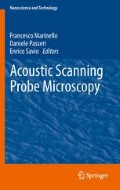Abstract
A version of scanning probe acoustic technique was developed as ultrasonic atomic force microscopy (UAFM), where higher order mode cantilever vibration is excited at its base (support). It enables precise imaging of both topography and elasticity of stiff samples such as metals and ceramics, without a need for bonding a transducer to the sample. By virtue of this advantage, a range of unique analysis and hardware has been developed. In this chapter, after briefly summarizing the concept of UAFM, basic mathematical analysis, mechanical, and electronic instrumentation are described, including a noise-free cantilever holder and analogue/digital fast resonance frequency tracking circuit. The final section describes illustrative examples first realized by this technique as an introduction for later chapters of applications (e.g. subsurface defects).
Access this chapter
Tax calculation will be finalised at checkout
Purchases are for personal use only
References
G. Binnig, C.F. Quate, Ch. Gerber, Phys. Rev. Lett. 12, 930 (1986)
O. Kolosov, K. Yamanaka, Jpn. J. Appl. Phys. 32, L1095 (1993)
K. Yamanaka, H. Ogiso, O. Kolosov, Appl. Phys. Lett. 64, 178 (1994)
U. Rabe, W. Arnold, Ann. Physik 3, 589 (1994)
U. Rabe, K. Janser, W. Arnold, Rev. Sci. Instrum. 67, 3281 (1996)
M. Radmacher, R.W. Tillmann, H.E. Gaub, Biophys. J. 64, 735 (1993)
K. Yamanaka, E. Tomita, Jpn. J. Appl. Phys. 34, 2879 (1995)
K. Yamanaka, S. Nakano, Jpn. J. Appl. Phys. 35, 3787 (1996)
K. Yamanaka, S. Nakano, Appl. Phys. A 66, 313 (1998)
K. Yamanaka, A. Noguchi, T. Tsuji, T. Koike, T. Goto, Surf. Interface Anal. 27, 600 (1999)
K. Yamanaka, U.S. Patent 6,006,593, 1999
T. Tsuji, K. Yamanaka, Nanotechnology 12, 301 (2001)
K. Yamanaka, Y. Maruyama, T. Tsuji, K. Nakamoto, Appl. Phys. Lett. 78, 1939 (2001)
T. Tsuji, H. Irihama, K. Yamanaka, Jpn. J. Appl. Phys. 41, 832 (2002)
K. Yamanaka, T. Tsuji, H. Irihama, T. Mihara, Proc. of SPIE 5045, 104 (2003)
K. Yamanaka, T. Mihara, T. Tsuji, Jpn. J. Appl. Phys. 43, 3082 (2004)
T. Tsuji, H. Ogiso, J. Akedo, S. Saito, K. Fukuda, K. Yamanaka, Jpn. J. Appl. Phys. 43, 2907 (2004)
T. Tsuji, S. Saito, K. Fukuda, K. Yamanaka, H. Ogiso, J. Akedo, K. Kawakami, Appl. Phys. Lett. 87, 071909 (2005)
T. Tsuji, K. Kobari, S. Ide, K. Yamanaka, Rev. Sci. Instrum. 78, 103703 (2007)
S. Ide, K. Kobari, T. Tsuji, K. Yamanaka, Jpn. J. Appl. Phys. 46, 4446 (2007)
K. Yamanaka, K. Kobari, T. Tsuji, Jpn. J. Appl. Phys. 47, 6070 (2008)
O. Wright, N. Nishiguchi, Appl. Phys. Lett. 71, 626 (1997)
U. Rabe, J. Turner, W. Arnold, Appl. Phys. A. 66, S277 (1998)
M. Reinstadtler, T. Kasai, U. Rabe, W. Arnold, J. Phys. D: Appl. Phys. 38, R269 (2005)
Y. Song, B. Bhushan, J. Appl. Phys. 99, 094911 (2006)
J.D. Adams, D. York, N. Whisman, Rev. Sci. Instrum. 75, 2903 (2004)
K. Kobayashi, H. Yamada, K. Matsushige, Surf. Interface Anal. 33, 89 (2002)
M.E. Lines, A.M. Glass, Principle and Applications of Ferroelectrics and Related Materials (Clarendon, Oxford, 1977), p. 100
S. Stemmer, S.K. Streiffer, F. Ernst, M. Ruhle, Philos. Mag. A 71, 713 (1995)
K. Matsuura, Y. Cho, R. Ramesh, Appl. Phys. Lett. 83, 2650 (2003)
D. Shilo, G. Ravichandran, K. Bhattacharya, Nat. Mater. 3, 453 (2004)
A. Gruverman, Nanoscale Characterization of Ferroelectric Materials, ed. by M. Alexe, A, Gruverman (Springer, New York, 2004)
U. Rabe, M. Kopycinska, S. Hirsekorn, J. Munoz Saldana, G.A. Schneider, W. Arnold, J. Phys. D: Appl. Phys. 35, 2621 (2002)
S.K.U. Kuno, Micromechanics of Composites (Hanser, New York, 1996), p. 15
T. Ikeda, Fundamentals of Piezoelectricity (Oxford University Press, New York, 2004)
Author information
Authors and Affiliations
Corresponding author
Editor information
Editors and Affiliations
Appendix A
Appendix A
The deflection vibration of a cantilever is expressed in the \(x--z\) plane as
where \(E\) is Young’s modulus, \(\rho \) is the density, \(A\) is the cross-section and \(I\) is the area moment of inertia. In the case of a rectangular lever of width \(a\) and thickness \(b\), \(I=ab^{3}/12\). At the end of the lever where \(x=L_1 \) , the deflection of the lever \(z\left({x,t} \right)\) produces a displacement of the apex of the tip of length \(h\) as \(\left[{h(\partial z/\partial x),z} \right]\) and the \(-z\) component of the shear force \(EI(\partial ^{3}z/\partial x^{3})\) caused by the vertical (out-of-plane) contact stiffness \(k^{*}\) of sample is
and the bending moment \(EI(\partial ^{2}z/\partial x^{2})\) is
when the tip is in contact with the sample with oblique angle \(\varphi \) with respect to the x-axis. Similarly, those forces caused by the lateral (in-plane) contact stiffness \(k_\text{ Lat}^*\) are
and
Then the boundary conditions at \(x=L_1 \) are
where \(\hat{{k}}_V^{*}=k^{*}\cos ^{2}\theta +k_\text{ Lat}^{*} \text{ sin}^{{2}}\varphi \), \(\hat{{k}}_\text{ Lat}^{*} =k_\text{ Lat}^{*} \cos ^{2}\varphi +k^{{*}}{sin}^{{2}}\varphi \) and \(\hat{{k}}_{\text{ LatV}}^{*}=(k_\text{ Lat}^{*}-k^{*})\cos \varphi \sin \varphi \). It is noted that if the vertical and lateral stiffness are identical \((k^{*}=k_\text{ Lat}^*)\) then \(\hat{{k}}_{\text{ LatV}}^{*} =0\) and \(\hat{{k}}_V^{*} =\hat{{k}}_\text{ Lat}^{*}=k^{*}\) and Eqs. (A6) and (A7) do not depend on the tilt angle \(\varphi \). This is in contrast to Ref. [6] where \(\hat{{k}}_{\text{ LatV}}^*=0\) does not hold when \(\hat{{k}}_V^*=\hat{{k}}_\text{ Lat}^*\). Equation (6.4) is obtained by substituting a solution of Eq. (A1) into the boundary conditions (A6) and (A7).
Rights and permissions
Copyright information
© 2013 Springer-Verlag Berlin Heidelberg
About this chapter
Cite this chapter
Yamanaka, K., Tsuji, T. (2013). Ultrasonic Atomic Force Microscopy UAFM. In: Marinello, F., Passeri, D., Savio, E. (eds) Acoustic Scanning Probe Microscopy. NanoScience and Technology. Springer, Berlin, Heidelberg. https://doi.org/10.1007/978-3-642-27494-7_6
Download citation
DOI: https://doi.org/10.1007/978-3-642-27494-7_6
Published:
Publisher Name: Springer, Berlin, Heidelberg
Print ISBN: 978-3-642-27493-0
Online ISBN: 978-3-642-27494-7
eBook Packages: Chemistry and Materials ScienceChemistry and Material Science (R0)

